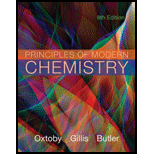
Principles of Modern Chemistry
8th Edition
ISBN: 9781305079113
Author: David W. Oxtoby, H. Pat Gillis, Laurie J. Butler
Publisher: Cengage Learning
expand_more
expand_more
format_list_bulleted
Question
error_outline
This textbook solution is under construction.
Students have asked these similar questions
Devise electrochemical cells in which the following reactions could be made to occur. If liquid
junctions are necessary, note them in the cell schematic appropriately, but neglect their effects.
(a) H2OH + OH¯
(b) 2H2O2
H₂O
(c) 2PbSO4 + 2H2O
(d) An
TMPD
PыO₂+ Pb + 4H+ + 20%¯¯
An + TMPD (in acetonitrile, where An and An are anthracene and its
anion radical, and TMPD and TMPD are N,N,N',N'-tetramethyl-p-phenylenediamine and its
cation radical. Use anthracene potentials for DMF solutions given in Appendix C.3).
(e) 2Ce3+ + 2H + BQ 2Ce4+ + H2Q (aqueous, where BQ is p-benzoquinone and H₂Q is p-
hydroquinone)
(f) Ag +Agl (aqueous)
(g) Fe3+ + Fe(CN)6 Fe²+ + Fe(CN) (aqueous)
Consider each of the following electrode-solution interfaces, and write the equation for the elec-
trode reaction that occurs first when the potential is moved in (1) a negative direction and (2) a posi-
tive direction from the open-circuit potential. Next to each reaction write the approximate potential
for the reaction in V vs. SCE (assuming the reaction is reversible).
(a) Pt/Cu2+ (0.01 M), Cd2+ (0.01 M), H2SO4(1 M)
(b) Pt/Sn2+ (0.01 M), Sn4+ (0.01 M), HCl(1 M)
(c) Hg/Cd2+ (0.01 M), Zn2+ (0.01 M), HCl(1 M)
What are the major products of both of the organic reactions. Please be sure to use wedge and dash bonds to show the stereochemistry of the products if it is needed. Please include the final product as well as a digram/drawing to show the mechanism of the reaction.
Knowledge Booster
Learn more about
Need a deep-dive on the concept behind this application? Look no further. Learn more about this topic, chemistry and related others by exploring similar questions and additional content below.Similar questions
- K Problem 16 of 24 Submit Draw the starting structure that would yield this product under these conditions. Select to Draw 1. NH4Cl, NaCN 2. HCI, H2O, A NH3 + 0arrow_forwardGive detailed me detailed mechanism Solution with explanation needed. Don't give Ai generated solution. avoid handwritten Solutionarrow_forwardShow work with explanation needed. don't give Ai generated solutionarrow_forward
- K Problem 21 of 24 Submit Draw the missing organic structures in the following multistep synthesis. Show the final product at physiological pH (pH = 7.4). Ignore any inorganic byproducts formed. H 0 NH3 Select to Draw HCN H+, H2O Select to Draw Select to Draw Δarrow_forwardShow work with explanation needed. Don't give Ai generated solution. Give correct solutionarrow_forwardK Problem 23 of 24 Submit Draw the product of the reaction shown below at physiological pH (pH = 7.4). Ignore inorganic byproducts. S O 1. NH3, 2. HCN 3. H+, H₂O, A Select to Drawarrow_forward
- Please correct answer and don't use hand rating and don't use Ai solutionarrow_forwardPlease correct answer and don't used hand raitingarrow_forward14. Draw all of the products expected for the following reaction. Circle the products expected to predominate when the reaction is heated to 40 °C. EXPLAIN your choice. (12 points) HBr ? Br -11arrow_forward
arrow_back_ios
SEE MORE QUESTIONS
arrow_forward_ios
Recommended textbooks for you
 Chemistry for Engineering StudentsChemistryISBN:9781337398909Author:Lawrence S. Brown, Tom HolmePublisher:Cengage Learning
Chemistry for Engineering StudentsChemistryISBN:9781337398909Author:Lawrence S. Brown, Tom HolmePublisher:Cengage Learning Chemistry: The Molecular ScienceChemistryISBN:9781285199047Author:John W. Moore, Conrad L. StanitskiPublisher:Cengage Learning
Chemistry: The Molecular ScienceChemistryISBN:9781285199047Author:John W. Moore, Conrad L. StanitskiPublisher:Cengage Learning ChemistryChemistryISBN:9781305957404Author:Steven S. Zumdahl, Susan A. Zumdahl, Donald J. DeCostePublisher:Cengage Learning
ChemistryChemistryISBN:9781305957404Author:Steven S. Zumdahl, Susan A. Zumdahl, Donald J. DeCostePublisher:Cengage Learning Chemistry for Engineering StudentsChemistryISBN:9781285199023Author:Lawrence S. Brown, Tom HolmePublisher:Cengage Learning
Chemistry for Engineering StudentsChemistryISBN:9781285199023Author:Lawrence S. Brown, Tom HolmePublisher:Cengage Learning Chemistry & Chemical ReactivityChemistryISBN:9781337399074Author:John C. Kotz, Paul M. Treichel, John Townsend, David TreichelPublisher:Cengage Learning
Chemistry & Chemical ReactivityChemistryISBN:9781337399074Author:John C. Kotz, Paul M. Treichel, John Townsend, David TreichelPublisher:Cengage Learning Chemistry: Principles and ReactionsChemistryISBN:9781305079373Author:William L. Masterton, Cecile N. HurleyPublisher:Cengage Learning
Chemistry: Principles and ReactionsChemistryISBN:9781305079373Author:William L. Masterton, Cecile N. HurleyPublisher:Cengage Learning

Chemistry for Engineering Students
Chemistry
ISBN:9781337398909
Author:Lawrence S. Brown, Tom Holme
Publisher:Cengage Learning

Chemistry: The Molecular Science
Chemistry
ISBN:9781285199047
Author:John W. Moore, Conrad L. Stanitski
Publisher:Cengage Learning

Chemistry
Chemistry
ISBN:9781305957404
Author:Steven S. Zumdahl, Susan A. Zumdahl, Donald J. DeCoste
Publisher:Cengage Learning

Chemistry for Engineering Students
Chemistry
ISBN:9781285199023
Author:Lawrence S. Brown, Tom Holme
Publisher:Cengage Learning

Chemistry & Chemical Reactivity
Chemistry
ISBN:9781337399074
Author:John C. Kotz, Paul M. Treichel, John Townsend, David Treichel
Publisher:Cengage Learning

Chemistry: Principles and Reactions
Chemistry
ISBN:9781305079373
Author:William L. Masterton, Cecile N. Hurley
Publisher:Cengage Learning
Kinetics: Chemistry's Demolition Derby - Crash Course Chemistry #32; Author: Crash Course;https://www.youtube.com/watch?v=7qOFtL3VEBc;License: Standard YouTube License, CC-BY